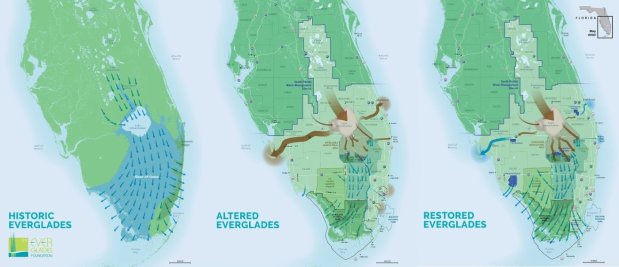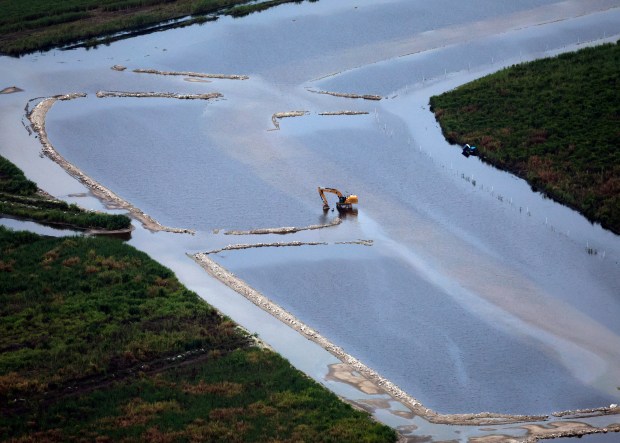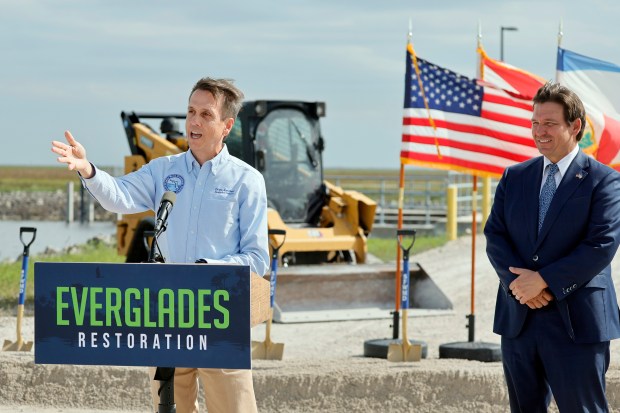The completion of a reservoir essential to Everglades restoration will come years ahead of schedule thanks to the early groundbreaking on a “huge” new pump station, Gov. Ron DeSantis said Thursday.
DeSantis celebrated the groundbreaking during a visit in western Palm Beach County and said that because of a July agreement that allows the state to take over construction of key restoration projects, the EAA Reservoir will be completed five years ahead of schedule, in 2029 instead of 2034.
When finished, the pump station, consisting of nine pumps, will be able to pull 3 billion gallons of water a day off Lake Okeechobee and into the Everglades Agricultural Area (EAA) Reservoir. Previously, the Army Corps of Engineers had been slated to build the pump station.
Under the July plan, the state will construct the inflow and outflow pump stations to the EAA Reservoir, said DeSantis, and the Army Corps will focus on building the reservoir’s basin and walls. The reservoir sits mainly above ground level, and will have 37-foot-tall earthen retaining walls, allowing for a 23-foot water depth.
The 10,000-acre, 78 billion-gallon reservoir is seen by DeSantis and others as the cornerstone of Everglades restoration. It will store excess water from Lake Okeechobee that was previously shunted through canals to the east and west coast, where it damaged estuaries and local economies, often resulting in blooms of sometimes-toxic blue-green algae and seagrass die-offs.
Water from the reservoir will then flow into a vast stormwater treatment area where, if the system works properly, it will be cleaned of harmful nutrients before being sent south into the Everglades.
This is meant to emulate how the “River of Grass” worked prior to the 20th century, when the construction of canals and levees divided and drained the Everglades, flooding some areas, such as the Miccosukee Reservation, while leaving other areas dry, and causing high salinity levels in Florida Bay.
When operational, the EAA will not only help Florida Bay, said DeSantis, it will provide water for the Biscayne aquifer, which is a source of drinking water for millions of people in South Florida.
“This pump station is huge. (It moves) 3 billion gallons of water per day,” said Drew Bartlett, director of the South Florida Water Management District, the state agency that will oversee the pump station’s construction.
 These three maps represent historic Everglades flow, altered flow and the eventual restored flow once the Comprehensive Everglades Restoration Plan is complete. (Courtesy Everglades Foundation)
These three maps represent historic Everglades flow, altered flow and the eventual restored flow once the Comprehensive Everglades Restoration Plan is complete. (Courtesy Everglades Foundation)
For reference, he said, all water supply systems in the SFWMD from the headwaters in Kissimmee down to Miami move 1.1 billion gallons per day.
“Why is it so big? Because it has to move rivers. It is moving the River of Grass, literally,” he said.
The Everglades watershed runs from just south of Orlando, through the Kissimmee River, Lake Okeechobee, then into the Everglades Agricultural Area. The water then travels into various wildlife conservation areas, Miccosukee and Seminole reservations and eventually Everglades National Park and Florida Bay.
 Construction of the EAA reservoir in the Everglades on Thursday, July 11, 2024. (Joe Cavaretta/South Florida Sun Sentinel, Aerial support provided by LightHawk)
Construction of the EAA reservoir in the Everglades on Thursday, July 11, 2024. (Joe Cavaretta/South Florida Sun Sentinel, Aerial support provided by LightHawk)
The pump station will accelerate that flow. “Right now the Kissimmee River is coming into Lake Okeechobee at 1 million gallons per day,” said Bartlett. “This could pull water off of Lake Okeechobee so that instead of going to the east and west coasts it’s coming south into this reservoir. It’s because of this pump station that we’re able to do that.”
The $23 billion Comprehensive Everglades Restoration Plan was passed by Congress in 2000 and involves dozens of projects to restore water flow to a more natural state across the southern tier of Florida. Some of those projects are complete, some have been severely delayed.
DeSantis outlined other Everglades restoration projects for which the state has assumed responsibility, such as the Blue Shanty Flow Way, which will allow more water flow under newly constructed bridges on the Tamiami Trail. The state broke ground on that project in September.
“It’s important to direct the water in this manner, because it represents the historic flow way through Shark River Slough,” said DeSantis. Shark River Slough historically provided Florida Bay with fresh water that allowed the bay to have healthy salinity levels.
High salinity and low oxygen levels have prompted seagrass die-offs and ensuing algae blooms in the bay. The restoration of more natural fresh water flow in the Everglades system is meant to help keep Florida Bay healthy.
 Florida Gov. Ron DeSantis looks on as South Florida Water Management District Executive Director Drew Bartlett speaks during a news conference in South Bay, Fla., on Thursday, Nov. 6, 2025. (Amy Beth Bennett / South Florida Sun Sentinel)
Florida Gov. Ron DeSantis looks on as South Florida Water Management District Executive Director Drew Bartlett speaks during a news conference in South Bay, Fla., on Thursday, Nov. 6, 2025. (Amy Beth Bennett / South Florida Sun Sentinel)
